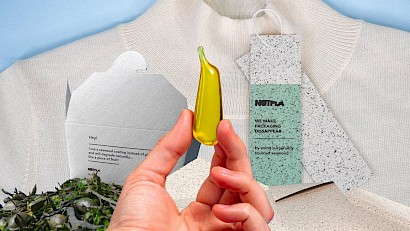Notpla's seaweed-based plastic can dissolve in water
 With a typical single-serve packet of instant coffee—the ready-to-brew kind that Starbucks and other brands sell for home and office use—the plastic wrapper ends up in the trash. In a prototype of a new seaweed-based packaging design, the wrapper dissolves into the drink, adding nutrients.
With a typical single-serve packet of instant coffee—the ready-to-brew kind that Starbucks and other brands sell for home and office use—the plastic wrapper ends up in the trash. In a prototype of a new seaweed-based packaging design, the wrapper dissolves into the drink, adding nutrients.
The design is from London-based Notpla (short for “not plastic”), which just raised $13 million in a Series A round of financing led by Horizon Ventures. The coffee packaging is one example of the company’s work to scale up sustainable packaging that can replace materials that are particularly hard to recycle—like thin plastic films—with packaging that can literally disappear. But the idea isn’t just to replace plastic with something less bad: The Notpla team believes it’s possible to improve on its performance.
“We’re leveraging the natural attributes of seaweed and things you find in nature and not only replacing things that have been made out of plastic, but rethinking the format,” says Pierre-Yves Paslier, co-CEO of Notpla. “One of the things that is quite exciting about seaweed is that it can do things that plastic cannot do. You create new behaviors that we wouldn’t be able to do with polyethylene or polypropylene.”
As the company’s team of chemists and designers started exploring new versions of seaweed-based film, Paslier says they “started to see a bunch of interesting formats and applications where solubility could be a big advantage.” Tea bags are often made with plastic, and a single bag can release as much as 11 billion microsize pieces of plastic and 3 billion nanosize particles into hot water, one study found. A tea bag made from seaweed can be safely stirred into the water instead, adding some fiber and antioxidants. The seaweed is processed so it doesn’t add any flavor.
The material can also be used for something like a pack of ramen noodles or a serving of rice so that the whole package can be dropped into hot water during preparation. “For people who go on a hike and want to bring back their packaging, it could be literally consumed within the meal,” Paslier says. Laundry detergent or dishwasher detergent pods could use the material instead of PVA plastic that ends up adding plastic pollution to waterways because it doesn’t fully dissolve.
Clothing, which is typically shipped in thin plastic bags, could be shipped in the seaweed-based material instead, and the material could be made with built-in detergent so that the whole package could be thrown into the laundry machine for the first wash. “We’re trying to think of how we can make a slightly more interesting and delightful experience while leveraging what plastic cannot do,” Paslier explains.
The company, which originally started with a design for an edible or biodegradable blob-like water bottle—something that it still produces for events like the London Marathon and music festivals—has been making prototypes of the new packaging for the past few months, working with large companies to partner on the designs. Now it’s beginning to scale up production, making rolls of film that can be used in the same industrial equipment that manufacturers currently use to make packaging from plastic. The new round of investment will help speed up industrialization.
“We’re really excited to see the response that the industry is having,” Paslier says. “With their minds broadening, and [the new investment] for putting a team and efforts together, I think we can go quite fast. Obviously, the scale of plastic is gigantic, and plastic has had, like, 100 years to be built itself. So it’s going to take a little bit of time for us to really challenge it in a global way. But I think that we can do that in a much shorter time than plastic took, because everyone is very committed to exploring these advances.”
You can return to the main Market News page, or press the Back button on your browser.

